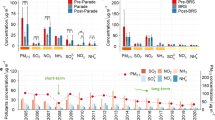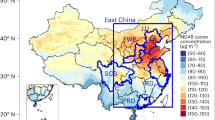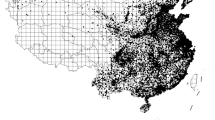Abstract
In China, short-term emission controls have been implemented widely in the host and nearby cities of major events to reduce air pollution. However, insufficient analysis of their effectiveness has weakened the design of pollution controls. In this study, we analyzed the impact of short-term controls on nitrogen oxide emissions and quantified their main drivers in both the host and neighboring cities of 11 events held in east China from 2010 to 2023. We found that short-term controls might be more effective in neighboring cities than in host cities for some events, and that their benefits in terms of reduced emissions have weakened over time. Furthermore, the main sector of emission abatement for events has shifted from power to industry and transportation, reflecting the evolution of emission controls and the relative dominance of air-pollution budgets for different sectors. Our analysis highlights the enhanced targeting of short-term air pollution controls for Chinese cities, which also supports the long-term policy design.
This is a preview of subscription content, access via your institution
Access options
Subscribe to this journal
Receive 12 digital issues and online access to articles
$119.00 per year
only $9.92 per issue
Buy this article
- Purchase on SpringerLink
- Instant access to full article PDF
Prices may be subject to local taxes which are calculated during checkout





Similar content being viewed by others
Data availability
The tropospheric NO2 column data from POMINO, POMINO-TROPOMI and GOME-2 were taken from http://www.pku-atmos-acm.org/acmProduct.php/ and https://www.temis.nl/. Meteorological variables were downloaded from the ERA5 hourly atmospheric reanalysis dataset (accessible at https://cds.climate.copernicus.eu/datasets/). Population density data were obtained from WordPop (https://hub.worldpop.org/geodata/summary?id=44833). The bottom-up emissions were taken from the Multiple-resolution Emission Inventory for China (http://www.meicmodel.org). The data produced in this study (RETOMI2 and the a posteriori emissions of NOx for the 11 events), as well as the source data for Figs. 1–5, are available via Figshare at https://figshare.com/s/d8b9b6e8b9f34ab5bdc8 (ref. 49). Source data are provided with this paper.
Code availability
The codes for predicting NO2 TVCDs using XGBoost and DINEOF and for estimating the a posteriori NOx emissions are available via Figshare at https://figshare.com/s/d8b9b6e8b9f34ab5bdc8 (ref. 49).
References
Circular of the State Council on Printing Out and Distribution of Action Plan on Air Pollution Prevention and Control Report No. Guofa (2013) 37 (in Chinese) (State Council of the People’s Republic of China, 2013); https://www.gov.cn/gongbao/content/2013/content_2496394.htm
Circular of the State Council on Printing Out and Distribution of Three-Year Action Plan on Defending the Blue Sky Report No. Guofa (2018) 22 (in Chinese) (State Council of the People’s Republic of China, 2018); https://www.gov.cn/gongbao/content/2018/content_5306820.htm
Huang, K. et al. How to improve the air quality over megacities in China: pollution characterization and source analysis in Shanghai before, during, and after the 2010 World Expo. Atmos. Chem. Phys. 13, 5927–5942 (2013).
Chan, K. L. et al. Observations of tropospheric NO2 using ground based MAX-DOAS and OMI measurements during the Shanghai World Expo 2010. Atmos. Environ. 119, 45–58 (2015).
Huang, Q. et al. Impacts of emission reduction and meteorological conditions on air quality improvement during the 2014 Youth Olympic Games in Nanjing, China. Atmos. Chem. Phys. 17, 13457–13471 (2017).
Ding, J. et al. NOX emission estimates during the 2014 Youth Olympic Games in Nanjing. Atmos. Chem. Phys. 15, 9399–9412 (2015).
Wang, Z. et al. Changes in atmospheric composition during the 2014 APEC conference in Beijing. J. Geophys. Res. Atmos. 120, 12695–12707 (2015).
Tao, M. H. et al. Contrasting effects of emission control on air pollution in Central China during the 2019 Military World Games based on satellite and ground observations. Atmos. Res. 259, 105657 (2021).
Ji, Y. et al. Counteractive effects of regional transport and emission control on the formation of fine particles: a case study during the Hangzhou G20 summit. Atmos. Chem. Phys. 18, 13581–13600 (2018).
Cheng, Y. F. et al. Traffic restrictions in Beijing during the Sino-African Summit 2006: aerosol size distribution and visibility compared to long-term in situ observations. Atmos. Chem. Phys. 8, 7583–7594 (2008).
Wang, S. X. et al. Quantifying the air pollutants emission reduction during the 2008 Olympic Games in Beijing. Environ. Sci. Technol. 44, 2490–2496 (2010).
Huang, K. et al. The ‘APEC Blue’ phenomenon: regional emission control effects observed from space. Atmos. Res. 164, 65–75 (2015).
Zheng, B. et al. Changes in China’s anthropogenic emissions and air quality during the COVID-19 pandemic in 2020. Earth Syst. Sci. Data 13, 2895–2907 (2021).
Martin, R. V. et al. Global inventory of nitrogen oxide emissions constrained by space-based observations of NO2 columns. J. Geophys. Res. Atmos. 108, 4537 (2003).
Beirle, S. et al. Megacity emissions and lifetimes of nitrogen oxides probed from space. Science 333, 1737–1739 (2011).
Beirle, S. et al. Pinpointing nitrogen oxide emissions from space. Sci. Adv. 5, eaax9800 (2019).
Kong, H. et al. Considerable unaccounted local sources of NOX emissions in China revealed from satellite. Environ. Sci. Technol. 56, 7131–7142 (2022).
Peng, X. L. et al. Spatially continuous mapping of daily global ozone distribution (2004–2014) with the Aura OMI sensor. J. Geophys. Res. Atmos. 121, 12702–12722 (2016).
Boersma, K. F., Eskes, H. J. & Brinksma, E. J. Error analysis for tropospheric NO2 retrieval from space. J. Geophys. Res. Atmos. 109, D04311 (2004).
Boersma, K. F. et al. An improved retrieval of tropospheric NO2 columns from the Ozone Monitoring Instrument. Atmos. Meas. Tech. 4, 1905–1928 (2011).
Liu, M. et al. A new TROPOMI product for tropospheric NO2 columns over East Asia with explicit aerosol corrections. Atmos. Meas. Tech. 13, 4247–4259 (2020).
Li, M. et al. Anthropogenic emission inventories in China: a review. Natl Sci. Rev. 4, 834–866 (2017).
Zheng, B. et al. Trends in China’s anthropogenic emissions since 2010 as the consequence of clean air actions. Atmos. Chem. Phys. 18, 14095–14111 (2018).
Yahya, K. et al. Decadal evaluation of regional climate, air quality, and their interactions over the continental US and their interactions using WRF/Chem version 3.6.1. Geosci. Model Dev. 9, 671–695 (2016).
Kang, D. et al. Simulating lightning NO production in CMAQv5.2: performance evaluations. Geosci. Model Dev. 12, 4409–4424 (2019).
Lin, J. T. et al. Retrieving tropospheric nitrogen dioxide from the Ozone Monitoring Instrument: effects of aerosols, surface reflectance anisotropy, and vertical profile of nitrogen dioxide. Atmos. Chem. Phys. 14, 1441–1461 (2014).
Liu, Y. M. & Wang, T. Worsening urban ozone pollution in China from 2013 to 2017—Part 2: the effects of emission changes and implications for multi-pollutant control. Atmos. Chem. Phys. 20, 6323–6337 (2020).
Wang, Y. T. et al. Sustained emission reductions have restrained the ozone pollution over China. Nat. Geosci. 16, 967–974 (2023).
Dong, X. Y. et al. Probe into gaseous pollution and assessment of air quality benefit under sector dependent emission control strategies over megacities in Yangtze River Delta, China. Atmos. Environ. 79, 841–852 (2013).
Liu, F. et al. Recent reduction in NOX emissions over China: synthesis of satellite observations and emission inventories. Environ. Res. Lett. 11, 114002 (2016).
Nanjing Winter and Spring Season Air Quality Assurance Control Program Report No. Ningzhengfa (2015) 225 (in Chinese) (The People’s Government of Nanjing, People’s Republic of China, 2015); http://www.nanjing.gov.cn/zdgk/201512/t20151229_1056755.html
Kong, H. et al. High-resolution (0.05° × 0.05°) NOx emissions in the Yangtze River Delta inferred from OMI. Atmos. Chem. Phys. 19, 12835–12856 (2019).
Liu, M. Y. et al. Improved aerosol correction for OMI tropospheric NO2 retrieval over East Asia: constraint from CALIOP aerosol vertical profile. Atmos. Meas. Tech. 12, 1–21 (2019).
Eskes, H. J. & Boersma, K. F. Averaging kernels for DOAS total-column satellite retrievals. Atmos. Chem. Phys. 3, 1285–1291 (2003).
Goldberg, D. L. et al. A top-down assessment using OMI NO2 suggests an underestimate in the NOx emissions inventory in Seoul, South Korea, during KORUS-AQ. Atmos. Chem. Phys. 19, 1801–1818 (2019).
Gong, P. et al. Finer resolution observation and monitoring of global land cover: first mapping results with Landsat TM and ETM+ data. Int. J. Remote Sens. 34, 2607–2654 (2013).
Tian, X. et al. Long-term observations of tropospheric NO2, SO2 and HCHO by MAX-DOAS in Yangtze River Delta area, China. J. Environ. Sci. 71, 207–221 (2018).
He, Q. et al. Spatially and temporally coherent reconstruction of tropospheric NO2 over China combining OMI and GOME-2B measurements. Environ. Res. Lett. 15, 125011 (2020).
Song, S. K. et al. Effects of natural and anthropogenic emissions on the composition and toxicity of aerosols in the marine atmosphere. Sci. Total Environ. 806, 150928 (2022).
Alvera-Azcárate, A. et al. Reconstruction of incomplete oceanographic data sets using empirical orthogonal functions: application to the Adriatic Sea surface temperature. Ocean Model. 9, 325–346 (2005).
Yang, J. Z. et al. Co-benefits of carbon and pollution control policies on air quality and health till 2030 in China. Environ. Int. 152, 683–693 (2021).
Zhao, C. & Wang, Y. H. Assimilated inversion of NOx emissions over east Asia using OMI NO2 column measurements. Geophys. Res. Lett. 36, L06805 (2009).
Qu, Z. et al. Global distribution of methane emissions: a comparative inverse analysis of observations from the TROPOMI and GOSAT satellite instruments. Atmos. Chem. Phys. 21, 14159–14175 (2021).
An, J. Y. et al. Emission inventory of air pollutants and chemical speciation for specific anthropogenic sources based on local measurements in the Yangtze River Delta region, China. Atmos. Chem. Phys. 21, 2003–2025 (2021).
Gu, C. et al. High-resolution regional emission inventory contributes to the evaluation of policy effectiveness: a case study in Jiangsu Province, China. Atmos. Chem. Phys. 23, 4247–4269 (2023).
Zheng, B. et al. Satellite-based estimates of decline and rebound in China’s CO2 emissions during COVID-19 pandemic. Sci. Adv. 6, eabd4998 (2020).
Kong, L. et al. Unbalanced emission reductions of different species and sectors in China during COVID-19 lockdown derived by multi-species surface observation assimilation. Atmos. Chem. Phys. 23, 6217–6240 (2023).
Xu, X. China’s Multi-year Provincial Administrative Division Boundary Data (Resource and Environment Science and Data Center, Institute of Geographic Sciences and Natural Resources Research, Chinese Academy of Sciences, 2023); https://doi.org/10.12078/2023010103
Wang, H. et al. Source data and code for research ‘Declining short-term emission control opportunity for major events in Chinese cities’. Figshare https://figshare.com/s/d8b9b6e8b9f34ab5bdc8 (2025).
Acknowledgements
We acknowledge the free use of tropospheric NO2 column data from the POMINO, POMINO-TROPOMI and GOME-2 sensors from http://www.pku-atmos-acm.org/acmProduct.php/ and https://www.temis.nl/. We also thank the data support from the National Earth System Science Data Center, National Science and Technology Infrastructure of China (http://www.geodata.cn). This work was supported by the National Key Research and Development Program of China (2023YFC3709802, Y.Z.) and the National Natural Science Foundation of China (42177080, Y.Z.).
Author information
Authors and Affiliations
Contributions
Conceptualization and methodology: H.W. and Y.Z.; formal analysis and investigation: H.W. and Y.Z.; writing (original draft): H.W. and Y.Z.; writing (review and editing): all authors; visualization: H.W.; code method support: H.W., Q.H., H.K., K.Q. and J.L.; data support: J.L. and B.Z.; supervision and project administration: Y.Z.
Corresponding author
Ethics declarations
Competing interests
The authors declare no competing interests.
Peer review
Peer review information
Nature Cities thanks Daiwen Kang, Minghao Qiu and the other, anonymous, reviewer(s) for their contribution to the peer review of this work.
Additional information
Publisher’s note Springer Nature remains neutral with regard to jurisdictional claims in published maps and institutional affiliations.
Supplementary information
Supplementary Information
Supplementary Text, Figs. 1–19 and Tables 1–12.
Source data
Source Data Fig. 1
Statistical source data.
Source Data Fig. 2
Statistical source data.
Source Data Fig. 3
Statistical source data.
Source Data Fig. 4
Statistical source data.
Source Data Fig. 5
Statistical source data.
Rights and permissions
Springer Nature or its licensor (e.g. a society or other partner) holds exclusive rights to this article under a publishing agreement with the author(s) or other rightsholder(s); author self-archiving of the accepted manuscript version of this article is solely governed by the terms of such publishing agreement and applicable law.
About this article
Cite this article
Wang, H., He, Q., Kong, H. et al. Declining short-term emission control opportunity for major events in Chinese cities. Nat Cities 2, 434–446 (2025). https://doi.org/10.1038/s44284-025-00233-x
Received:
Accepted:
Published:
Issue date:
DOI: https://doi.org/10.1038/s44284-025-00233-x



